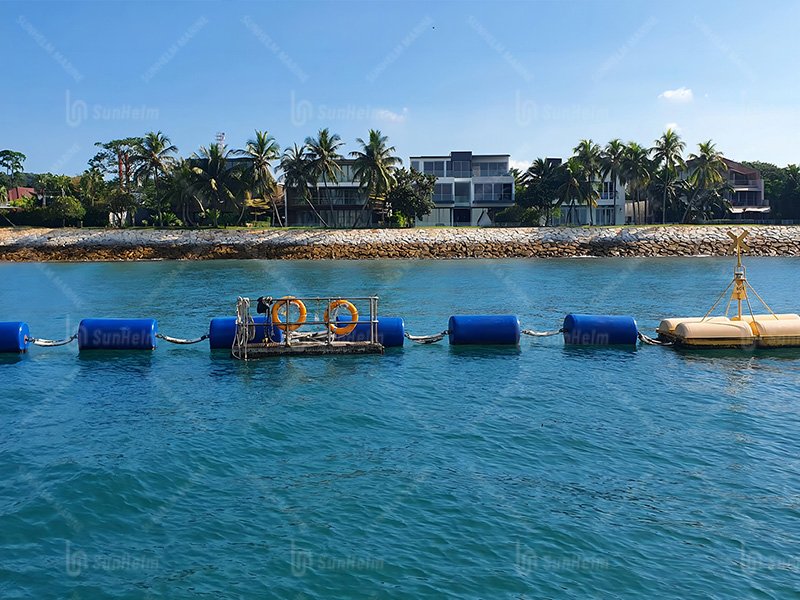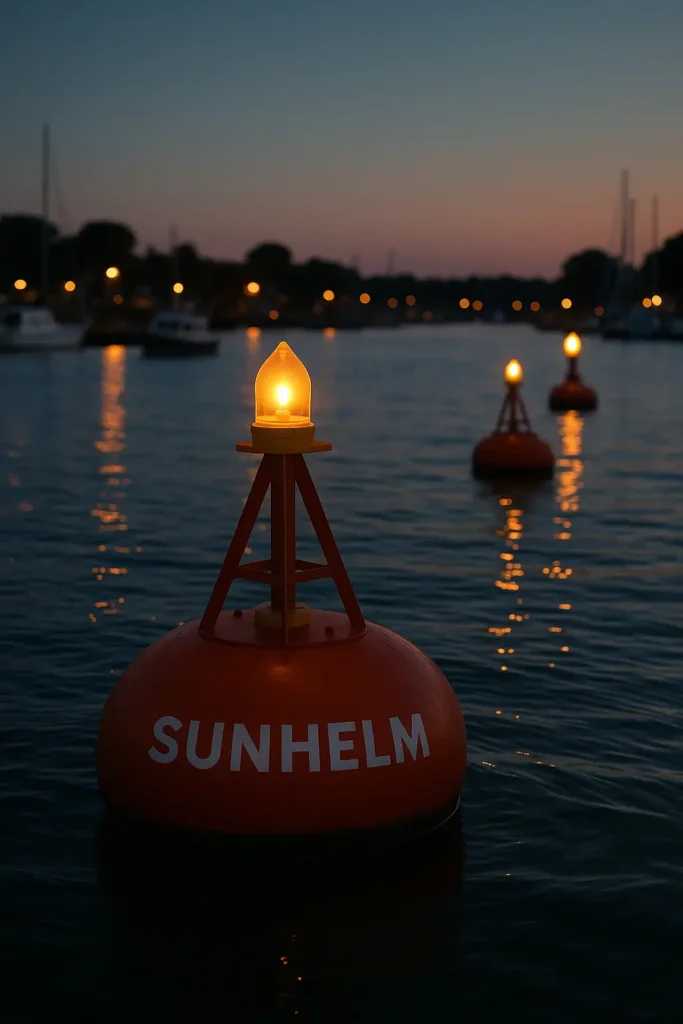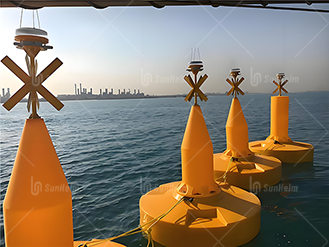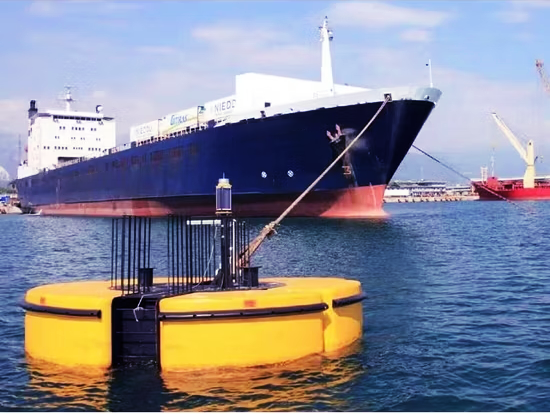1. Small Buoy, Big Job
When ships move across the sea, a small buoy can often stop a big accident. A buoy is not only a “road sign” for ships but also an important tool for port safety. Whether it’s a narrow channel, a busy harbor, or a dredging area, buoys always guide ships, mark danger, and keep order.
But how can such a simple floating object protect navigation and even help track bad weather at sea? Let Sunhelmmarine take you through how buoys really work.
2. What Is a Buoy?
A buoy is a floating marker placed on the water’s surface. It is usually made of steel or foam and is used to mark channels, safe waters, danger zones, or mooring points.
Each buoy has its own color, shape, light, or sound signal to guide ships safely.
Companies like Sunhelmmarine make strong, corrosion-resistant, and impact-proof buoys for ports and marine projects around the world. These buoys are built to handle the toughest sea conditions and keep navigation safe.

3. How Buoys Float and Stay in Place
A buoy floats because of buoyancy—when it pushes aside (displaces) more water than it weighs, it stays on the surface.
To keep it from drifting away, a buoy is held down by a mooring system. This includes a heavy sinker, mooring lines, and connectors.
- The sinker gives weight.
- The mooring lines absorb wave shock so the buoy can move gently but still stay in position.
The mooring line is usually three to five times the water depth, which helps the buoy stay steady even when tides rise or fall.
4. Main Types of Buoys and Their Uses
Different buoys do different jobs. Here are the most common ones:
- Lateral Buoys – Mark the sides of a channel.
- Red marks the left side (even numbers).
- Green marks the right side (odd numbers).
The higher the number, the closer you are to land.
- Regulatory Buoys – White with orange markings, used to show rules like “No Anchoring” or “Speed Limit.”
- Isolated Danger Buoys – Show a single hazard like a reef or wreck. They are black and red with two black balls on top.
- Safe Water Buoys – Red and white stripes. Show that water all around is safe and clear of danger. Usually found in the center of a channel.
- Special Buoys – Yellow buoys used for dredging, construction, or aquaculture zones.
- Mooring Buoys – Used for ships to tie up and stay in place, often found near docks or anchor zones.
Different colors and shapes make buoys work like traffic lights on the sea, helping ships move safely in busy waters.
5. Lights, Sounds, and Marks — The “Language” of Buoys
Buoys don’t just rely on color or shape. They also use lights and sounds to send messages.
At night, flash patterns and colors tell you what kind of buoy it is.
- One white flash means a Safe Water Buoy.
- Red and green flashes show channel sides.
Some lights can be seen up to 10 nautical miles away.
In foggy weather, buoys may have bells, horns, or whistles to warn nearby vessels.
All major ports follow the IALA buoyage system, so no matter if you’re sailing in Asia or Europe, buoy rules look the same.

6. How to Navigate Safely with Buoys
Safe sailing depends on knowing how to read and use buoys correctly.
- Before sailing: Check your charts and the latest notices to see where buoys are placed or changed.
- When approaching a channel: Confirm the buoy’s color, shape, and light match the chart.
- Control speed: Slow down in crowded or mooring areas to avoid damaging buoys or causing large waves.
- Use navigation tools: Combine buoy signals with AIS, GPS, and radar for better positioning.
- During dredging or construction: Contact port control to avoid entering closed or restricted areas.
Sunhelmmarine provides dredging and temporary navigation buoys for ports around the world, helping them stay safe even during construction.
7. Buoy Maintenance and Inspection
A buoy’s reliability depends on regular care. Ports should have a routine inspection plan, including:
- Checking for cracks, fading, or marine growth on the buoy body.
- Inspecting mooring lines and connectors for wear or rust.
- Testing lights, batteries, and reflectors.
- Recording drift or damage and replacing parts quickly.
Common problems include corroded mooring lines, dead lights, or drifting buoys.
Regular maintenance lowers accident risk and saves repair costs later.
Many ports work with trusted suppliers like Sunhelmmarine to ensure spare parts and technical support are always ready.
8. Buoy System Planning in Port Design
For port designers and planners, buoy layout is a key part of safe navigation.
They must consider:
- Water depth and current speed.
- Traffic density and ship routes.
- Seabed shape and tide changes.
- Visibility and weather patterns.
A good design keeps buoys spaced safely, easy to see, and includes backup plans.
Buoys should work together with lighthouses, signal towers, and electronic aids to form a full safety network.
Ports should also prepare emergency buoy plans for accidents or temporary channel closures.
9. Limits and Risks of Buoys
Buoys are helpful, but they are not perfect.
Strong winds, waves, or currents can move them off position.
Fog, ice, or darkness can make them hard to see.
They can be hit by ships, stolen, or lose their mooring chain.
That’s why sailors must always use charts, radios, and good judgment — never rely on buoys alone.
10. Real-World Examples
- Dredging Project: Sunhelmmarine supplied bright yellow buoys to mark a temporary construction zone, helping dredgers work safely.
- Night Entry: Crews used light flashes and AIS data to follow Safe Water Buoys while entering port.
- After a Storm: Port workers inspected the buoy system and reset two that had drifted.
These examples show how proper buoy use and care greatly improve port safety.

11. Quick Checklist for Buoy Use
- Before departure: Check updated charts and buoy positions.
- When near buoys: Verify color, shape, and light pattern.
- While mooring: Slow down and avoid creating big waves.
- After sailing: Report any drift or damage.
12. FAQ
1. What should I do if a buoy drifts away?
Slow down, note your position, and report it to port control.
2. How often are buoys maintained?
Usually every 6–12 months, depending on sea conditions.
3. Can buoys replace GPS?
No. Buoys are visual aids and should be used with electronic navigation systems.
4. Who maintains buoys?
Usually the port or waterway authority, with technical support from professional suppliers like Sunhelmmarine.
13. Conclusion
Buoys may look small, but they are key to keeping the sea safe and organized.
From marking channels to guiding ships and warning of hazards, buoys keep marine traffic running smoothly.
Working with reliable and experienced suppliers like Sunhelmmarine helps ports and sailors keep their buoy systems strong and dependable — making every voyage safer and more confident.


